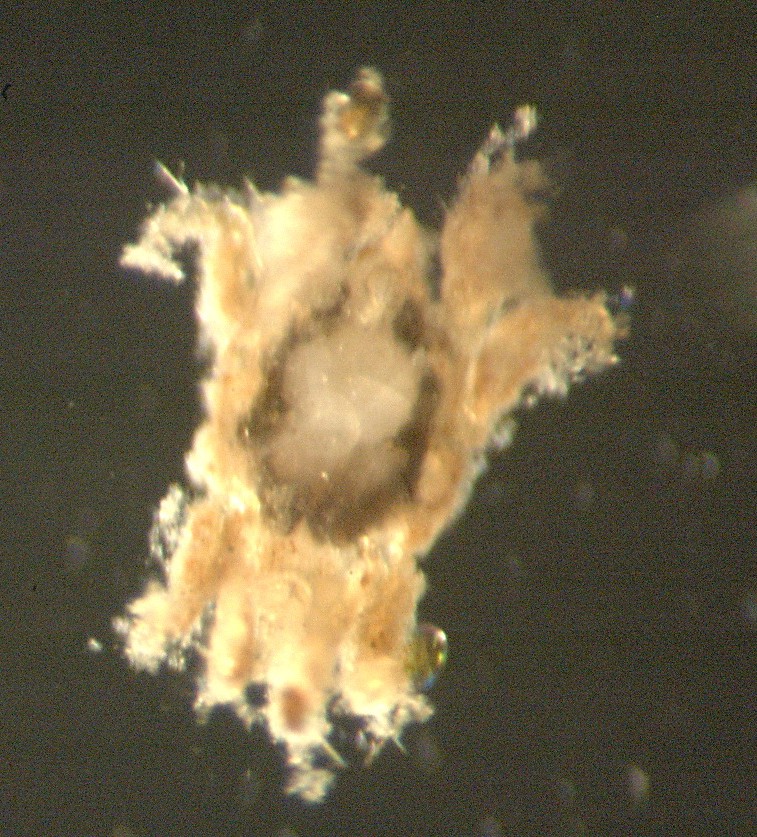Halacaridae: Marine mitesCommon name(s): |
|
| Synonyms: |  |
|
Phylum Arthropoda
Subphylum Chelicerata
Class Arachnida
Superorder Acariformes
Order Trombidiformes
Suborder Prostigmata
|
|
| A marine mite of Family Halacaridae. Total length about 1/2 mm. Many diatoms and other debris are adhered to the legs. This individual was crawling around on a subtidal barnacle. | |
| (Photo by: Dave Cowles, August 2008 ) | |
How to Distinguish from Similar Species: The "velvet mite" Neomulgus littoralis is a commonly encountered species found in the high intertidal and supralittoral. It is bright red and may reach 3-4 mm long. Thinoseius orchestoidae is a member of Suborder Mesostigmata. It attaches to the undersides of the beachhoppers Traskorchestia and Megalorchestia and preys upon nematodes that also live on the amphipods. Members of Suborder Astigmata are mostly small, weakly sclerotized forms that are often found around green algae in tide pools. Suborder Orbatida are dark, heavily sclerotized mites that are often herbivorous and found in the upper intertidal.
Geographical Range:
Depth Range: Members of this family live from intertidal down to at least 5000 m depth.
Habitat: Members of the family live in many different habtats, though individual species tend to be habitat-specific.
Biology/Natural History: Some marine mites are phytophagous (suck from plants/algae), some are predators, and some are parasites. The shape and habits of this individual suggest that it is a predator.
Halacaridae use spermatophores during reproduction. One of their larval stages has only 6 legs instead of 8. The larval stages are followed by one to several nymphal instars before they become adults. At least 14 genera of Halacaridae are found in the Pacific Northwest.
Unlike the few insects and spiders which may be found in
marine habitats
but must breathe air, mites are able to absorb oxygen from the water so
they can live at great depths.
| Return to: | |||
| Main Page | Alphabetic Index | Systematic Index | Glossary |
References:
Dichotomous Keys:Carlton, 2007 (Most information is here)
Kozloff, 1987, 1996
Smith and Carlton, 1975
General
References:
Morris
et al., 1980
Scientific
Articles:
Bartsch, I., 2004. Geographical and ecological distribution
of
marine halacarid genera and species. Experimental and Applied
Acarology
34: 37-58
Kitron, U. D., 1980. The pattern of infestation of the beach-hopper amphpod Orchestoidea corniculata, by a parasitic mite, Parasitology 81: 235-249
Krantz, G. W., 1973. Four new predatory species of Halacaridae (Acari: Prostigmata) from Oregon with remarks on their distribution in the intertidal mussel habitat (Pelecypoda: Mytilidae). Annals. Entomological Society of America 66: 979-985
Krantz, G. W., 1976. Arenicolous Halacaridae from the intertidal zone of Schooner Creek, Oregon (Acari: Prostigmata). Acarologia 18: 241-258
McQuitty, M., 1984. The marine Halacaroidea from California. Journal of Natural History 18: 527-554
Rigby, M. C., 1996. The epibionts of beach hoppers (Crustacea: Talitridae) of the North American Pacific coast. Journal of Natural History 30: 1329-1336
Web sites:
General Notes and Observations: Locations, abundances, unusual behaviors:
Authors and Editors of Page:
Dave Cowles (2008): Created original page
CSS coding for page developed by Jonathan Cowles (2007)